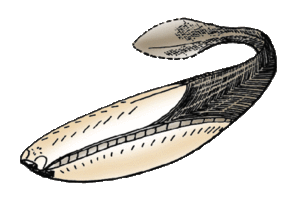Arandaspida
| Arandaspida | ||||||||||||
|---|---|---|---|---|---|---|---|---|---|---|---|---|

Sacabambaspis from Bolivia, the best researched arandaspide. |
||||||||||||
| Temporal occurrence | ||||||||||||
| Ordovician | ||||||||||||
| 485.4 to 443.4 million years | ||||||||||||
| Locations | ||||||||||||
|
||||||||||||
| Systematics | ||||||||||||
|
||||||||||||
| Scientific name | ||||||||||||
| Arandaspida | ||||||||||||
| Ritchie & Gilbert-Tomlinson , 1977 |
The Arandaspida , also called Arandaspidida or as an order by Nelson Arandaspidiformes , are a group of extinct, fish-like, armored vertebrates and known from fossils from sediments of the Ordovician . They only occurred in the sea.
features
The Arandaspida were small to medium-sized fish with body lengths of 10 to 40 cm. They had a fish-like, elongated shape with a caudal fin. The head and the front part of the body were covered by a rather flat dorsal and a convex ventral bone plate, in between the gill openings with special gill plates. The dorsal and ventral bone plates were made up of smaller bone plates ("tesserae") that had grown together at their base. On their outer surface they showed teardrop-shaped or oak leaf-shaped tubercles. They probably didn't have dentin . Between the dorsal and ventral bone plates there were about 20 smaller, diamond-shaped plates, between which the numerous (10 to more than 15) small gill openings lay. All bone plates were very thin (<1 mm) and built up in three layers, consisting of a thin basal layer, a spongy middle layer and a porous outer layer. The eyes, which were located above the horizontal mouth opening surrounded by numerous, elongated, small scales in a bulge of the dorsal shield that was very far forward, were protected by a strong bone ring. Between the eyes were two small, closely spaced openings that might have been nostrils or contained a pair of pineal organs . Like most recent fish, the Arandaspida had a lateral line organ that lay in narrow pits between the tubercles on the dorsal and ventral shield.
The internal anatomy of the animals is unknown, the hind body may have been flattened laterally and covered with long, vertical scales. The caudal fin, which has only survived incompletely, was possibly spade-shaped and diphycerk . Paired fins, dorsal and anal fin were missing.
Systematics
The Arandaspida are the first vertebrates whose membership of the Vertebrata is not doubted (in contrast to the Conodonta ). Within the vertebrates they belong to the Pteraspidomorphi because of their large dorsal and ventral plates . Four genera are known, of which Sacabambaspis has been best researched. All are from the middle Ordovician, but fragmented Arandaspida bones were also recovered from the lower and upper Ordovician.
Genera with localities:
- Arandaspis (Australia)
- Porophoraspis (Australia)
- Sacabambaspis (Argentina, Bolivia and Oman)
- Andinaspis (Bolivia)
literature
- Michael J. Benton : Paleontology of the vertebrates. 2007, ISBN 3-89937-072-4 .
- Robert L. Carroll: Paleontology and Evolution of the Vertebrates , Thieme, Stuttgart (1993), ISBN 3-13774-401-6 .
- John A. Long: The Rise of Fishes . The Johns Hopkins University Press, 1995, ISBN 0-80184-992-6 .
- Joseph S. Nelson : Fishes of the World . John Wiley & Sons, 2006, ISBN 0-471-25031-7 .
- Hans-Peter Schultze: Pteraspidomorphi Page 183 in: Wilfried Westheide & Reinhard Rieger: Special Zoology Part 2: Vertebrae and Skull Animals , 1st edition, Spectrum Academic Publishing Heidelberg • Berlin, 2004, ISBN 3-8274-0307-3 .
Web links
- Philippe Janvier. 1997. Arandaspida. in The Tree of Life Web Project
- Palaeos: Arandaspida
- The Paleobiology Database: Arandaspida
